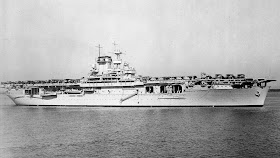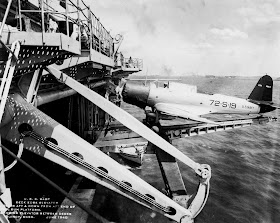 |
| The USS Wasp in 1940 (Wikipedia) |
The Wasp (CV-7) was a scaled down Yorktown-class carrier and a product of the Washington Naval Treaty. After the Yorktown and Enterprise were built, the US still had 15,000 tons allowed for an additional carrier under the treaty. Since the Navy wanted as big an air wing as possible on the Wasp despite the ship being about 25% smaller than the Yorktown class, a number of torpedo protection features were omitted from the design that would have protected her stores and machinery spaces. The carrier also had less armor protection topside. Her machinery was less powerful than even the Independence-class CVLs. The Wasp's machinery was capable of 75,000 shaft-horsepower. The Yorktown's power plant could do 120,000 shp, the Essex-class had a power plant capable of 150,000 shp and that of the Independence-class CVLs could do 100,000 shp.
The Wasp had the first deck edge elevator- it was a T-shaped platform to accommodate the tailwheel at the top and the mainwheels on the cross part. Though instead of running vertically on side rails, articulated arms moved the elevator in a semicircular path from the hangar deck to the flight deck.
 |
| The deck edge elevator of the USS Wasp with a Vought SB2U Vindicator (National Museum of Naval Aviation/Wikipedia) |
The Wasp was commissioned on 25 April 1940. Her final sea trials took place on 26 September 1940 and was afterwards assigned to the Atlantic Fleet with the homeport at Norfolk, Virginia. One of her earliest assignments were experiments to see if Army aircraft, in this case Curtiss P-40 Warhawks, could be flown off the carrier. Interestingly while on Neutrality Patrol in the summer of 1941, the Wasp participated in the search for the German cruiser Admiral Hipper. With the declaration of war in December 1941, the Wasp's first tasking was in the Caribbean to intercept any French warships which were feared to be under Vichy control and would attempt a breakout to reach France. With carrier losses in the Pacific after the Battle of Coral Sea and the Battle of Midway reducing the US Pacific fleet to only three carriers, the Wasp was urgently transferred from the Atlantic Fleet to the Pacific Fleet. It was participation in the Guadalcanal campaign with the USS Saratoga and the USS Enterprise that the Wasp would be lost.
The design omissions to meet Washington Treaty stipulations would prove fatal in 1942 when she was torpedoed during the Guadalcanal campaign by the submarine I-19. Early war inexperience with damage control was also a factor in the Wasp's sinking. I-19 fired six torpedoes- three hit the Wasp in the area of its fuel bunkers and magazines with disastrous effect. The fourth torpedo hit the escorting destroyer USS O'Brien, the fifth and six torpedoes missing. Thirty-five minutes after being hit, Captain Forrest P. Sherman gave the order to abandon ship. She later had to be sunk by one of the escorting destroyers. Of her air wing, 45 aircraft went down with her, but of the 26 aircraft that were airborne at the time of the attack, all but one were recovered aboard the USS Hornet. 193 men died with 366 wounded.
 |
| The Wasp ablaze shortly after the three torpedo hits (Wikipedia) |
Further reading:

No comments:
Post a Comment